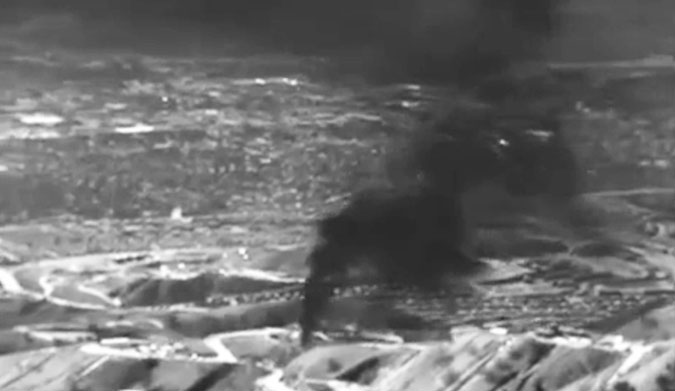
Just because you can’t see it doesn’t mean it’s not there. A massive methane leak in hills above Los Angeles is violently spewing hundreds of thousands of pounds of gas into the atmosphere… and there’s no end in sight.
There’s something terrible happening right now that you might not have heard about. Deep beneath the earth in Southern California’s Aliso Canyon, an almost unimaginable amount of methane gas is spewing violently from a ruptured gas line–and there’s no way to stop it. Some are calling it “the worst environmental catastrophe since the BP oil spill“.
Back at the end of October, officials found the broken line an underground containment area in the hills above Burbank, Los Angeles. The facility is owned by the Southern California Gas Company, and according to the Washington Post, it “contains billions of cubic feet of natural gas, stored under pressure to supply the company’s 20 million customers.” As of Christmas Day, almost 200 million pounds of methane have been released into the atmosphere, and because of the nature of the leak, there’s no end in sight. While there are ongoing containment efforts, California officials are now saying there’s no way of stopping it for months.
Recent infrared aerial footage shows what can’t be seen with the naked eye: a massive plume of methane escaping from the storage facility, just a stone’s throw from the San Fernando Valley.
So far, the cause of the leak isn’t known, but speculation is that when a well casing broke, the gas began escaping through natural fissures in the earth. When it reached the surface, the California Air Resources Board recorded the escape rate at somewhere around 110,000 pounds per hour.
Since methane is naturally colorless and odorless, the leak has less visible impacts than the catastrophic Deepwater Horizon spill, and therefore much less media exposure–but make no mistake, this is on par with the devastation in the Gulf, just in a different way. When it first began two months ago, the leak “instantly became the biggest single source of methane emissions in all of California,” according to the Washington Post. Environmentalists studying the leak say that over a 20-year period, the amount of methane being released into the atmosphere is the same as the emissions from 7 million automobiles.
Thousands of families from Porter Ranch, a gated community near the site of the leak, have been relocated, many with almost no idea of when they’ll be back in their homes. The gas company, of course, is saying that the leak poses no risk to human health, as methane dissipates relatively quickly. Many people, however, have reported the noxious fumes have made them sick. Methane in its natural state is odorless, but as a safety measure, methanethiol is added to give it a sulphur smell as a warning sign.
The California Air Resources Board is estimating that the leak has increased the entire state of California’s greenhouse gas emissions by as much as 25%. Aircraft has been banned from flying over the area, and SoCal Gas has tried in vain to stop the leak. It’s most recent effort–much like the one used in the Deepwater Horizon spill–was a relief well drilled alongside the leak. A solution was poured down the new well in an attempt to plug the ruptured pipe, but the amount of methane escaping made it impossible.

